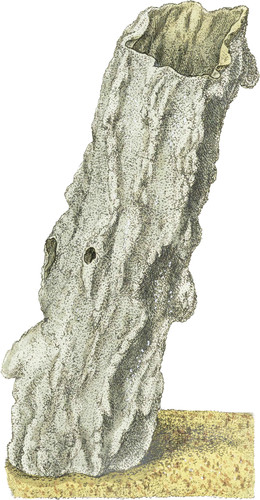 Enlarge
Enlarge
British Mineralogy
Vitrified Sand tubes
- Syn.
- Vitreous tubes. Trans. of Geo. Soc. vol. 2. p. 528.
- Ceraunian Sinter. Syn. Brit. Mus. p. 16.
- Blitz-Sinter.
’Ere I terminate this work I have the satisfaction to add the figure of another phenomenon almost as extraordinary as the Meteor stones, and nearly as difficult to conjecture the origin of, although we see it must be of comparatively recent formation. That tubular accretions of sand should be formed in a sand bank, forty feet above the sea, on the coast, with every apparent sign of vitrification within, is certainly much out of the usual course of nature's operations. The discovery of these tubes was made by E. L. Irton, Esq. at Drigg, in Cumberland; who perceived the ends standing above the loose sand like little chimney pots; they were exposed by the drifting of the sand. Mr. Irton’s zeal for investigating them had nearly cost him his life, for he got buried up to his throat in sand while searching for their terminations: in 1812 he bad followed one to the depth of fifteen feet, and next year the sand had been carried away to more than that depth by the wind, and the excavation was continued to twenty-nine feet, whore the tube, which had hitherto followed a perpendicular course, met with a bed of pebbles, and was united to one composed of a greenish grey hornstone porphyry; here its course was rendered oblique for a short distance, but it resumed its perpendicular direction; it was much diminished in diameter, but the termination was lost, after proceeding another foot, by the sand falling in. There were three tubes found near each other on one bank, others have been met with in the neighbourhood, but they are so brittle that the wind soon destroys them, and they can only be discovered soon after the wind has removed the surface of the sandbanks; they are generally inclined, and have a few short reflected branches (one specimen was furcated); when they enter the bed of pebbles above mentioned, they pass in a zigzag direction from one stone to another, and are then gradually lost in a dark colour given to the sand: they are seldom straight in any part of their length, and are often perforated by small holes:* the sides are always much and very irregularly plaited so as sometimes even to meet and close the tube; their greatest diameter at the top is about two inches; the branches are often not more than the fourth part of an inch wide and are short: the interior is smooth and shining hut uneven, composed of a difficultly fusible transparent and whitish glass, containing a few vesicles and some dark grey specks; the outside is much corrugated and rough from the adherence of the sandy granules. The sand near them is changed to a dark grey from a pale reddish colour, by the blackening of the redder grains, and the white granules of Quartz have become opaque. The origin of these tubes appears to be well explained at the end of the second volume of the Geological Society’s Transactions, where it is shown that the sand consists of grains of greenish black fusible hornstone porphyry and Quartz, but that there is not enough of the former to flux the Quartz, except in a heat urged by oxygen gas; by the help of which a similar glass might be produced—and that the banks are in a favourable situation for discharging the electricity of the clouds coming from the sea; that the sand being an imperfect conductor would be perforated in the way a quire of paper or a glass jar is sometimes done by electricians; now the heat of a flash of lightning is more than equal to that produced in small experiments in oxygen, and, therefore, would very probably fuse the sand in its passage; the pressure of the surrounding sand would wrinkle the sides of the tubes before they could cool and thus give them their irregular form. Their terminations, among the moist gravel at high watermark, discovered since the publication of the Transactions, serves to strengthen this theory; it is observed also, from the shifting nature of the sand banks, the tubes must be of recent formation. I am indebted to C. König, Esq. of the British Museum, for the following information:—
“These sand tubes were first observed in the Senner Heide, (Setraer Heath) in the county of Lippe, in Germany, where, on account of their being considered as the results of lightning, they are known by the name of Blitz-Rohren (lightning tubes). The form of the German tubes is exactly like that of the English ones, but they are frequently not more than ft quarter of an inch in diameter. I understand they are referred by Emmerling and Lentz to the Kiesel Sinter of Werner: the latter author calls this variety Blitz Sinter from its supposed origin.”
- * Our specimen in the Geological Society’s collection is so much perforated as to resemble lace.

